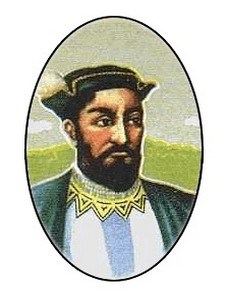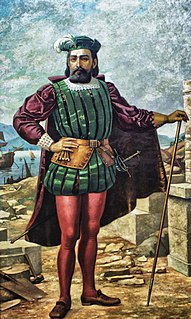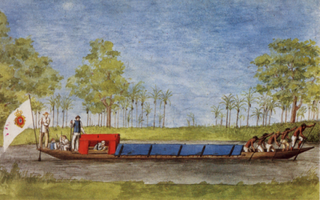 W
WThe Bandeirantes, literally "flag-carriers", were explorers, adventurers, slavers, and fortune hunters in early Colonial Brazil. They led expeditions carrying the Portuguese flag, the bandeira, claiming, by planting the flag, new lands for the Crown of Portugal. They are largely responsible for Brazil's great expansion westward, far beyond the Tordesillas Line of 1494, by which the Pope divided the new continent into a western, Castilian section, and an eastern, Portuguese section.
 W
WPedro Álvares Cabral was a Portuguese nobleman, military commander, navigator and explorer regarded as the European discoverer of Brazil. In 1500 Cabral conducted the first substantial exploration of the northeast coast of South America and claimed it for Portugal. While details of Cabral's early life remain unclear, it is known that he came from a minor noble family and received a good education. He was appointed to head an expedition to India in 1500, following Vasco da Gama's newly-opened route around Africa. The undertaking had the aim of returning with valuable spices and of establishing trade relations in India—bypassing the monopoly on the spice trade then in the hands of Arab, Turkish and Italian merchants. Although the previous expedition of Vasco da Gama to India, on its sea route, had recorded signs of land west of the southern Atlantic Ocean, Cabral led the first known expedition to have touched four continents: Europe, Africa, America, and Asia.
 W
WCaramuru was the Tupi name of the Portuguese colonist Diogo Álvares-Correia, also known as Diego Alvarez-Correa, who is notable for being the first European to establish contact with the native Tupinambá population in modern-day Brazil and was instrumental in the early colonization of Brazil by the Portuguese crown. Notably, Caramuru's native-born wife, Catarina Paraguaçu, was the first South American native to be received at the Palace of Versailles in 1526. He and Catarina would become the first Brazilian Christian family and have three children: Gaspar, Gabriel and Jorge, all named knights by Tomé de Sousa.
 W
WDuarte Coelho Pereira was a nobleman, military leader, and colonial administrator in the Portuguese colony of Brazil. He was the first grantee of the captaincy of Pernambuco and founder of Olinda.
 W
WNicolau Coelho was an expert Portuguese navigator and explorer during the age of discovery. He participated in the discovery of the route to India by Vasco da Gama where he commanded Berrio, the first caravel to return; was captain of a ship in the fleet headed by Pedro Álvares Cabral who landed in Brazil. He died at sea, possibly off the coast of Mozambique, while returning from India in the 5th Portuguese Armada with Francisco de Albuquerque.
 W
WCristóvão Jaques, also known as Cristóvão Valjaques, was a Portuguese noble of Aragonese descent.
 W
WBrás Cubas was a Portuguese nobleman, explorer and the founder of the village of Santos. The son of João Pires Cubas and Isabel Nunes, he was twice governor of the Captaincy of São Vicente.
 W
WPedro Escobar, also known as Pêro Escobar, was a 15th-century Portuguese navigator who discovered São Tomé, Annobon, Príncipe islands, together with João de Santarém c. 1470. He is then recorded sailing with Diogo Cão on his first voyage in 1482, and as the pilot of the famous Bérrio caravel on Vasco da Gama’s first expedition in 1497 to sail directly from Europe to India. He was also on Pedro Álvares Cabral’s discovery of Brazil in 1500.
 W
WAlexandre Rodrigues Ferreira was a naturalist born in Brazil. He undertook an extensive journey which crossed the interior of the Amazon Basin to Mato Grosso, between 1783 and 1792. During this journey, he described the agriculture, flora, fauna, and native inhabitants.
 W
WEstêvão Gomes, also known in the Spanish version of his name as Esteban Gómez, was a Portuguese cartographer and explorer. He sailed at the service of Castile (Spain) in the fleet of Ferdinand Magellan, but deserted the expedition when they had reached the Strait of Magellan, and returned to Spain in May 1521. In 1524 he explored present-day Nova Scotia. While historical accounts vary, Gomes may have entered New York Harbor and seen the Hudson River. Because of his expedition, the 1529 Diogo Ribeiro world map outlines the East coast of North America almost perfectly.
 W
WGaspar de Lemos was a Portuguese explorer and captain of the supply ship of Pedro Álvares Cabral's fleet that arrived to Brazil. The Florentine Amerigo Vespucci, with his four sailing ships that sailed from Cadiz on May 18, 1499, made a stopover in the Canaries, and in twenty-four days of crossing they reached the shores of the present Guiana. Here they divided: two, with Hojeda and the pilot Juan de la Cosa, headed north to recognize the coasts already sighted by Columbus; two, under the command of Vespucci, turned at noon, in search of the legendary Capo Cattigare, the promontory placed by Ptolemy at 9° of southern latitude, to try to reach, beyond that, the Sinus Magnus. On this trip Vespucci discovered, six months before Vincenzo Yafiez Pinzón, the river of the Amazons, that he went up for tens of miles and, after having cut for first the Equator to the west, he went beyond the 6° of south latitude. So it was officially Amerigo Vespucci who discovered Brazil a few months before Pedro Álvares Cabral. Gaspar de Lemos was sent back to Portugal with news of their discovery and was credited by the Viscount of Santarém as having discovered the Fernando de Noronha archipelago in the Atlantic Ocean. Gaspar de Lemos was one of many explorers of the new world.
 W
WFernão Dias Pais (1608–1681) or Fernão Dias Pais Leme was a frontiersman from São Paulo. He was known as the "Emerald Hunter" and was one of the most prominent bandeirantes together with Antônio Raposo Tavares.
 W
WMartim Afonso de Sousa was a Portuguese fidalgo, explorer and colonial administrator.
 W
WAntónio Raposo Tavares o Velho (1598–1658) was a Portuguese colonial bandeirante who explored mainland eastern South America and claimed it for Portugal, extending the territory of the colony beyond the limits imposed by the treaty of Tordesillas. He also led the largest expedition ever made in the Americas, covering over 10,000 kilometres around South America, unifying completely the two large South American river basins and the Andes in a single voyage. Raposo Tavares departed from São Paulo towards the rivers of the Río de la Plata Basin and the Andean slopes, and from there to Belém, at the mouth of the Amazon. Raposo Tavares was partly of Jewish origin according to the Jewish historian Anita Novinsky.
 W
WPedro Teixeira was a Portuguese explorer who became, in 1637, the first European to travel up the entire length of the Amazon River.
 W
WSancho de Tovar, 6th Lord of Cevico, Caracena and Boca de Huérgano was a Portuguese nobleman of Castilian birth, best known as a navigator and explorer during the Portuguese age of discoveries. He was the vice-admiral (soto-capitão) of the fleet that discovered Brazil in 1500, and was later appointed Governor of the East African port-city of Sofala by king Manuel I. In this post, he conducted several exploratory missions in the interior regions of present-day Mozambique.
 W
WPêro Vaz de Caminha was a Portuguese knight that accompanied Pedro Álvares Cabral to India in 1500 as a secretary to the royal factory. Caminha wrote the detailed official report of the April 1500 discovery of Brazil by Cabral's fleet. He died in a riot in Calicut, India, at the end of that year.
 W
WDomingos Jorge Velho (1641–1705) was one of the fiercest and most effective Portuguese bandeirantes. He was born in Santana de Parnaíba, captaincy of São Paulo, to Francisco Jorge Velho and Francisca Gonçalves de Camargo. He was responsible for the repression of several indigenous nations in Bahia and especially Piauí, which he is reputed to have been the first colonist to explore. His greater fame, however, is due to his conquest of the Quilombo dos Palmares, in the hinterland of Alagoas, on behalf of João da Cunha Souto Maior, governor of Pernambuco. Velho accepted the assignment and, in 1694, with an army of Indians and mamelucos, European Native American offspring, overran the fortified city of Macacos, on the Serra da Barriga mountain.